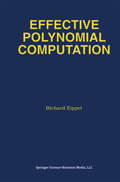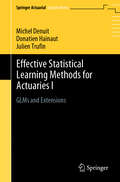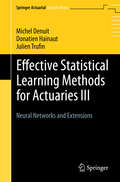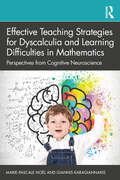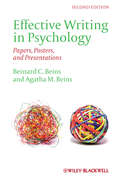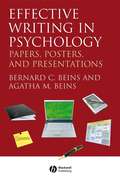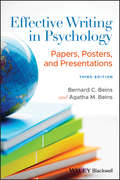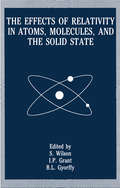- Table View
- List View
Effective Methods for Software Engineering
by Boyd L. SummersSoftware is important because it is used by a great many people in companies and institutions. This book presents engineering methods for designing and building software. Based on the author’s experience in software engineering as a programmer in the defense and aerospace industries, this book explains how to ensure a software that is programmed operates according to its requirements. It also shows how to develop, operate, and maintain software engineering capabilities by instilling an engineering discipline to support programming, design, builds, and delivery to customers. This book helps software engineers to: Understand the basic concepts, standards, and requirements of software engineering. Select the appropriate programming and design techniques. Effectively use software engineering tools and applications. Create specifications to comply with the software standards and requirements. Utilize various methods and techniques to identify defects. Manage changes to standards and requirements. Besides providing a technical view, this book discusses the moral and ethical responsibility of software engineers to ensure that the software they design and program does not cause serious problems. Software engineers tend to be concerned with the technical elegance of their software products and tools, whereas customers tend to be concerned only with whether a software product meets their needs and is easy and ready to use. This book looks at these two sides of software development and the challenges they present for software engineering. A critical understanding of software engineering empowers developers to choose the right methods for achieving effective results. Effective Methods for Software Engineering guides software programmers and developers to develop this critical understanding that is so crucial in today’s software-dependent society.
Effective Methods for Software Engineering
by Boyd L. SummersSoftware is important because it is used by a great many people in companies and institutions. This book presents engineering methods for designing and building software. Based on the author’s experience in software engineering as a programmer in the defense and aerospace industries, this book explains how to ensure a software that is programmed operates according to its requirements. It also shows how to develop, operate, and maintain software engineering capabilities by instilling an engineering discipline to support programming, design, builds, and delivery to customers. This book helps software engineers to: Understand the basic concepts, standards, and requirements of software engineering. Select the appropriate programming and design techniques. Effectively use software engineering tools and applications. Create specifications to comply with the software standards and requirements. Utilize various methods and techniques to identify defects. Manage changes to standards and requirements. Besides providing a technical view, this book discusses the moral and ethical responsibility of software engineers to ensure that the software they design and program does not cause serious problems. Software engineers tend to be concerned with the technical elegance of their software products and tools, whereas customers tend to be concerned only with whether a software product meets their needs and is easy and ready to use. This book looks at these two sides of software development and the challenges they present for software engineering. A critical understanding of software engineering empowers developers to choose the right methods for achieving effective results. Effective Methods for Software Engineering guides software programmers and developers to develop this critical understanding that is so crucial in today’s software-dependent society.
Effective Methods in Algebraic Geometry (Progress in Mathematics #94)
by T. Mora C. TraversoThe symposium "MEGA-90 - Effective Methods in Algebraic Geome try" was held in Castiglioncello (Livorno, Italy) in April 17-211990. The themes - we quote from the "Call for papers" - were the fol lowing: - Effective methods and complexity issues in commutative algebra, pro jective geometry, real geometry, algebraic number theory - Algebraic geometric methods in algebraic computing Contributions in related fields (computational aspects of group theory, differential algebra and geometry, algebraic and differential topology, etc.) were also welcome. The origin and the motivation of such a meeting, that is supposed to be the first of a series, deserves to be explained. The subject - the theory and the practice of computation in alge braic geometry and related domains from the mathematical viewpoin- has been one of the themes of the symposia organized by SIGSAM (the Special Interest Group for Symbolic and Algebraic Manipulation of the Association for Computing Machinery), SAME (Symbolic and Algebraic Manipulation in Europe), and AAECC (the semantics of the name is vary ing; an average meaning is "Applied Algebra and Error Correcting Codes").
Effective Non-Hermiticity and Topology in Markovian Quadratic Bosonic Dynamics (Springer Theses)
by Vincent Paul FlynnThis thesis provides an in-depth investigation of effective non-Hermiticity and topology in many-mode, non-interacting, bosonic systems. It also establishes the extent to which one must move beyond the Hamiltonian, closed-system setting, in order to uncover signatures of genuine symmetry-protected topological (SPT) physics in "free" (mean-field) bosons. While SPT phases of free fermionic matter and their associated zero-energy boundary-localized modes have been thoroughly explored, similar physics in free bosonic systems still remains elusive. No fermionic counterpart exists for the distinctive dynamical behavior that arises from the effective non-Hermiticity, intrinsic even at equilibrium, to bosonic Hamiltonians. Therefore, a much needed paradigm shift is required to address major conceptual roadblocks in the search for SPT bosonic phases.The analysis within develops, in particular, the notion of topological metastability in quadratic bosonic systems subject to Markovian dissipation. The resulting dynamical paradigm was found to be characterized by both a sharp separation between transient and asymptotic dynamics and non-trivial topological invariants. It also features long-lived boundary-localized "Majorana boson" and "Dirac boson" modes, which realize tight bosonic analogues to the edge modes characteristic of fermionic SPT phases. This comprehensive look into non-interacting bosonic systems breaks important new ground for re-imagining quantum phenomena beyond equilibrium, with novel applications in quantum science.
Effective Polynomial Computation (The Springer International Series in Engineering and Computer Science #241)
by Richard ZippelEffective Polynomial Computation is an introduction to the algorithms of computer algebra. It discusses the basic algorithms for manipulating polynomials including factoring polynomials. These algorithms are discussed from both a theoretical and practical perspective. Those cases where theoretically optimal algorithms are inappropriate are discussed and the practical alternatives are explained. Effective Polynomial Computation provides much of the mathematical motivation of the algorithms discussed to help the reader appreciate the mathematical mechanisms underlying the algorithms, and so that the algorithms will not appear to be constructed out of whole cloth. Preparatory to the discussion of algorithms for polynomials, the first third of this book discusses related issues in elementary number theory. These results are either used in later algorithms (e.g. the discussion of lattices and Diophantine approximation), or analogs of the number theoretic algorithms are used for polynomial problems (e.g. Euclidean algorithm and p-adic numbers). Among the unique features of Effective Polynomial Computation is the detailed material on greatest common divisor and factoring algorithms for sparse multivariate polynomials. In addition, both deterministic and probabilistic algorithms for irreducibility testing of polynomials are discussed.
Effective Statistical Learning Methods for Actuaries I: GLMs and Extensions (Springer Actuarial)
by Michel Denuit Donatien Hainaut Julien TrufinThis book summarizes the state of the art in generalized linear models (GLMs) and their various extensions: GAMs, mixed models and credibility, and some nonlinear variants (GNMs). In order to deal with tail events, analytical tools from Extreme Value Theory are presented. Going beyond mean modeling, it considers volatility modeling (double GLMs) and the general modeling of location, scale and shape parameters (GAMLSS). Actuaries need these advanced analytical tools to turn the massive data sets now at their disposal into opportunities. The exposition alternates between methodological aspects and case studies, providing numerical illustrations using the R statistical software. The technical prerequisites are kept at a reasonable level in order to reach a broad readership. This is the first of three volumes entitled Effective Statistical Learning Methods for Actuaries. Written by actuaries for actuaries, this series offers a comprehensive overview of insurance data analytics with applications to P&C, life and health insurance. Although closely related to the other two volumes, this volume can be read independently.
Effective Statistical Learning Methods for Actuaries II: Tree-Based Methods and Extensions (Springer Actuarial)
by Michel Denuit Donatien Hainaut Julien TrufinThis book summarizes the state of the art in tree-based methods for insurance: regression trees, random forests and boosting methods. It also exhibits the tools which make it possible to assess the predictive performance of tree-based models. Actuaries need these advanced analytical tools to turn the massive data sets now at their disposal into opportunities. The exposition alternates between methodological aspects and numerical illustrations or case studies. All numerical illustrations are performed with the R statistical software. The technical prerequisites are kept at a reasonable level in order to reach a broad readership. In particular, master's students in actuarial sciences and actuaries wishing to update their skills in machine learning will find the book useful. This is the second of three volumes entitled Effective Statistical Learning Methods for Actuaries. Written by actuaries for actuaries, this series offers a comprehensive overview of insurance data analytics with applications to P&C, life and health insurance.
Effective Statistical Learning Methods for Actuaries III: Neural Networks and Extensions (Springer Actuarial)
by Michel Denuit Donatien Hainaut Julien TrufinThis book reviews some of the most recent developments in neural networks, with a focus on applications in actuarial sciences and finance. It simultaneously introduces the relevant tools for developing and analyzing neural networks, in a style that is mathematically rigorous yet accessible. Artificial intelligence and neural networks offer a powerful alternative to statistical methods for analyzing data. Various topics are covered from feed-forward networks to deep learning, such as Bayesian learning, boosting methods and Long Short Term Memory models. All methods are applied to claims, mortality or time-series forecasting. Requiring only a basic knowledge of statistics, this book is written for masters students in the actuarial sciences and for actuaries wishing to update their skills in machine learning. This is the third of three volumes entitled Effective Statistical Learning Methods for Actuaries. Written by actuaries for actuaries, this series offers a comprehensive overview of insurance data analytics with applications to P&C, life and health insurance. Although closely related to the other two volumes, this volume can be read independently.
Effective Teaching Strategies for Dyscalculia and Learning Difficulties in Mathematics: Perspectives from Cognitive Neuroscience
by Marie-Pascale Noël Giannis KaragiannakisEffective Teaching Strategies for Dyscalculia and Learning Difficulties in Mathematics provides an essential bridge between scientific research and practical interventions with children. It unpacks what we know about the possible cognitive causation of mathematical difficulties in order to improve teaching and therefore learning. Each chapter considers a specific domain of children’s numerical development: counting and the understanding of numbers, understanding of the base-10 system, arithmetic, word problem solving, and understanding rational numbers. The accessible guidance includes a literature review on each topic, surveying how each process develops in children, the difficulties encountered at that level by some pupils, and the intervention studies that have been published. It guides the reader step-by-step through practical guidelines of how to assess these processes and how to build an intervention to help children master them. Illustrated throughout with examples of materials used in the effective interventions described, this essential guide offers deep understanding and effective strategies for developmental and educational psychologists, special educational needs and/or disabilities coordinators, and teachers working with children experiencing mathematical difficulties.
Effective Teaching Strategies for Dyscalculia and Learning Difficulties in Mathematics: Perspectives from Cognitive Neuroscience
by Marie-Pascale Noël Giannis KaragiannakisEffective Teaching Strategies for Dyscalculia and Learning Difficulties in Mathematics provides an essential bridge between scientific research and practical interventions with children. It unpacks what we know about the possible cognitive causation of mathematical difficulties in order to improve teaching and therefore learning. Each chapter considers a specific domain of children’s numerical development: counting and the understanding of numbers, understanding of the base-10 system, arithmetic, word problem solving, and understanding rational numbers. The accessible guidance includes a literature review on each topic, surveying how each process develops in children, the difficulties encountered at that level by some pupils, and the intervention studies that have been published. It guides the reader step-by-step through practical guidelines of how to assess these processes and how to build an intervention to help children master them. Illustrated throughout with examples of materials used in the effective interventions described, this essential guide offers deep understanding and effective strategies for developmental and educational psychologists, special educational needs and/or disabilities coordinators, and teachers working with children experiencing mathematical difficulties.
Effective Theories in Physics: From Planetary Orbits to Elementary Particle Masses (SpringerBriefs in Physics)
by James D. WellsThis open access book…There is significant interest in the Philosophy of Science community to understand the role that "effective theories" have in the work of forefront science. The ideas of effective theories have been implicit in science for a long time, but have only been articulated well in the last few decades. Since Wilson's renormalization group revolution in the early 1970's, the science community has come to more fully understand its power, and by the mid-1990's it had gained its apotheosis. It is still one of the most powerful concepts in science, which has direct impact in how one thinks about and formulates theories of nature. It is this power that this Brief sets out to emphasize through historical analysis and current examples.This is an open access book.
Effective Writing in Psychology: Papers, Posters,and Presentations (Wiley Desktop Editions Ser.)
by Bernard C. Beins Agatha M. BeinsThe second edition of Effective Writing in Psychology helps users produce crisp scientific communication, form concise unambiguous arguments, and render technical information clear and comprehensible. The new edition incorporates the latest guidelines contained within the 6th edition of the APA Publication Manual. Clear guidelines on effective writing illustrate how to generate strong and compelling prose, even when the writing is not aimed at a research audience Incorporates changes to the guidelines contained in the 6th edition of the APA publication manual Includes material on how to adapt APA style for poster presentations using PowerPoint, and for oral presentations Contains a new section on using the Internet to present research papers and a new chapter on conducting a literature search, to guide students through databases, keywords, sources, and connections between articles Highlights methods for selecting a research topic and organizing papers Features a sample manuscript showing common deviations from correct APA style and a version demonstrating appropriate use of APA style
Effective Writing in Psychology: Papers, Posters,and Presentations
by Bernard C. Beins Agatha M. BeinsThe second edition of Effective Writing in Psychology helps users produce crisp scientific communication, form concise unambiguous arguments, and render technical information clear and comprehensible. The new edition incorporates the latest guidelines contained within the 6th edition of the APA Publication Manual. Clear guidelines on effective writing illustrate how to generate strong and compelling prose, even when the writing is not aimed at a research audience Incorporates changes to the guidelines contained in the 6th edition of the APA publication manual Includes material on how to adapt APA style for poster presentations using PowerPoint, and for oral presentations Contains a new section on using the Internet to present research papers and a new chapter on conducting a literature search, to guide students through databases, keywords, sources, and connections between articles Highlights methods for selecting a research topic and organizing papers Features a sample manuscript showing common deviations from correct APA style and a version demonstrating appropriate use of APA style
Effective Writing in Psychology: Papers, Posters, and Presentations (Wiley Desktop Editions Ser.)
by Bernard C. Beins Agatha M. BeinsThis book helps students, writers and speakers at all levels refine their communication skills by guiding them at every stage of the process. Focuses on principles of good writing and writing in APA style Offers tips on internet publishing, poster presentations, and making presentations to Institutional Review Boards (IRBs) Highlights methods for selecting a research topic, organizing papers and communicating statistics in an accessible way
Effective Writing in Psychology: Papers, Posters, and Presentations
by Bernard C. Beins Agatha M. BeinsMaster the art of APA-style writing with this newly updated and accessible resource The newly and thoroughly revised Third Edition of Effective Writing in Psychology: Papers, Posters, and Presentations offers compelling and comprehensive guidance to readers who want to create powerful and persuasive prose in a rigorous, scientific, and APA-compliant framework. Distinguished academics and authors Bernard and Agatha Beins walk readers through the foundational and advanced topics they must grasp to generate convincing and credible APA-stye writing. The book combines an accessible and approachable guide to effective writing with the most current best practices from the 7th edition of the American Psychological Association's publication manual. New writers and experienced authors alike will benefit from Effective Writing in Psychology's descriptions of the most frequently used and important aspects of APA-style writing. The authors minimize their use of technical jargon and include explanations of how to create effective posters, deliver high-quality oral presentations, and publish electronically. The book also includes: An up-to-date presentation of ethical, inclusive writing and proper use of modern pronouns Step-by-step guidance on the use of APA formatting in scholarly papers Explanations of how to create effective posters for poster sessions Descriptions of how to organize convincing and credible oral presentations that leave listeners and conference attendees impressed and edified The basics of creating and formatting electronic documents for publication on the web Effective Writing in Psychology: Papers, Posters, and Presentations is an invaluable resource for psychology and social, and behavioral science students at any level. It also belongs on the bookshelves of practicing psychology professionals, researchers, and academics who would like to brush up on their technical writing abilities.
Effective Writing in Psychology: Papers, Posters, and Presentations (Wiley Desktop Editions Ser.)
by Bernard C. Beins Agatha M. BeinsMaster the art of APA-style writing with this newly updated and accessible resource The newly and thoroughly revised Third Edition of Effective Writing in Psychology: Papers, Posters, and Presentations offers compelling and comprehensive guidance to readers who want to create powerful and persuasive prose in a rigorous, scientific, and APA-compliant framework. Distinguished academics and authors Bernard and Agatha Beins walk readers through the foundational and advanced topics they must grasp to generate convincing and credible APA-stye writing. The book combines an accessible and approachable guide to effective writing with the most current best practices from the 7th edition of the American Psychological Association's publication manual. New writers and experienced authors alike will benefit from Effective Writing in Psychology's descriptions of the most frequently used and important aspects of APA-style writing. The authors minimize their use of technical jargon and include explanations of how to create effective posters, deliver high-quality oral presentations, and publish electronically. The book also includes: An up-to-date presentation of ethical, inclusive writing and proper use of modern pronouns Step-by-step guidance on the use of APA formatting in scholarly papers Explanations of how to create effective posters for poster sessions Descriptions of how to organize convincing and credible oral presentations that leave listeners and conference attendees impressed and edified The basics of creating and formatting electronic documents for publication on the web Effective Writing in Psychology: Papers, Posters, and Presentations is an invaluable resource for psychology and social, and behavioral science students at any level. It also belongs on the bookshelves of practicing psychology professionals, researchers, and academics who would like to brush up on their technical writing abilities.
The Effectiveness of Mathematics Teaching in Primary Schools: Lessons from England and China (Routledge Research in International and Comparative Education)
by Zhenzhen Miao David ReynoldsThe Effectiveness of Mathematics Teaching in Primary Schools: Lessons from England and China provides a unique insight into the mathematics classrooms of these two countries and arrives at a time when the world is eager to know how Chinese learners consistently excel at learning mathematics and other core subjects. Showcasing the kinds of teaching methods that work within and across countries, this book presents a rich collection of views, including those from teachers, their native colleagues, their foreign colleagues and the researcher, regarding the quality of mathematics teaching today. Interweaving scientific results about teaching and learning evaluations with multiple perspectives of various roles in and out of the classroom, Miao and Reynolds offer insights into how and why different approaches of teaching have led to different learning outcomes in mathematics internationally. Building on rigid and robust analyses of the most up-to-date data in England and China, the book indicates that it is through changing teaching rather than changing teachers that mathematics learning can be improved, because it is what teachers do in the classroom that really makes a big difference. Containing four decades of wisdom from the field of teaching effectiveness research, this book is essential reading for all who want to improve the quality of mathematics teaching worldwide. This book is particularly relevant for educational researchers, postgraduate students and teachers, as well as school leaders, policymakers and parents.
The Effectiveness of Mathematics Teaching in Primary Schools: Lessons from England and China (Routledge Research in International and Comparative Education)
by Zhenzhen Miao David ReynoldsThe Effectiveness of Mathematics Teaching in Primary Schools: Lessons from England and China provides a unique insight into the mathematics classrooms of these two countries and arrives at a time when the world is eager to know how Chinese learners consistently excel at learning mathematics and other core subjects. Showcasing the kinds of teaching methods that work within and across countries, this book presents a rich collection of views, including those from teachers, their native colleagues, their foreign colleagues and the researcher, regarding the quality of mathematics teaching today. Interweaving scientific results about teaching and learning evaluations with multiple perspectives of various roles in and out of the classroom, Miao and Reynolds offer insights into how and why different approaches of teaching have led to different learning outcomes in mathematics internationally. Building on rigid and robust analyses of the most up-to-date data in England and China, the book indicates that it is through changing teaching rather than changing teachers that mathematics learning can be improved, because it is what teachers do in the classroom that really makes a big difference. Containing four decades of wisdom from the field of teaching effectiveness research, this book is essential reading for all who want to improve the quality of mathematics teaching worldwide. This book is particularly relevant for educational researchers, postgraduate students and teachers, as well as school leaders, policymakers and parents.
The Effects of Deregulation on U.S. Air Networks (Advances in Spatial and Network Economics)
by Aisling J. Reynolds-Feighan1. 1 A Brief History of U. S. Commercial Aviation Regulation and Deregulation The U. S. commercial aviation industry was regulated by the government for a period of 40 years, beginning in 1938 with. the passing of the Federal Aviation Act, and ending in October 1978 when President Carter signed into law the Airline Deregulation Act (ADA). There were 16 airlines in existence when the Federal Aviation Act was passed in 1938 (the so-called 'trunk lines'). The Act established the Civil Aeronautics Authority (CAA) as the industry's regulatory body. The Act was passed principally because it was felt that the free market, if allowed to continue unregulated for much longer, would put many of these firms into bankruptcy. It is possible therefore to view the CAA of 1938 (re-organized into the Civil Aeronautics Board (CAB) in 1940) as a response to a potential market failure at the time. In the 1930s, few air traffic markets could have efficiently"supported more than one airline operating in the market [Panzar (1980)]. Competition among the carriers was cut-throat, and it was felt that the near bankruptcy of the airlines in the period was caused principally by the competitive bidding system used by the Post Office in allotting airmail subsidies [Keeler (1972), Caves (1962)].
Effects of Magnetoelastic Interactions in Conductive Plates and Shells (Foundations of Engineering Mechanics)
by Gevorg Baghdasaryan Marine MikilyanThis book investigates the stability and vibrations of conductive, perfectly conductive and superconductive thin bodies in electromagnetic fields. It introduces the main principles and derives basic equations and relations describing interconnected mechanical and electromagnetic processes in deformable electro conductive bodies placed in an external inhomogeneous magnetic field and under the influence of various types of force interactions. Basic equations and relations are addressed in the nonlinear formulation and special emphasis is placed on the mechanical interactions of superconducting thin-body plates with magnetic fields.
Effects of Non-locality in Gravity and Quantum Theory (Springer Theses)
by Jens BoosThis thesis is devoted to the systematic study of non-local theories that respect Lorentz invariance and are devoid of new, unphysical degrees of freedom. Such theories are attractive for phenomenological applications since they are mostly unconstrained by current experiments. Non-locality has played an increasingly important role in the physics of the last decades, appearing in effective actions in quantum field theory, and arising naturally in string theory and non-commutative geometry. It may even be a necessary ingredient for quantum theories of gravity. It is a feature of quantum entanglement, and may even solve the long-standing black hole information loss problem. “Non-locality” is a broad concept with many promising and fruitful applications in theoretical and mathematical physics. After a historical and pedagogical introduction into the concept of non-locality the author develops the notion of non-local Green functions to study various non-local weak-field problems in quantum mechanics, quantum field theory, gravity, and quantum field theory in curved spacetime. This thesis fills a gap in the literature by providing a self-contained exploration of weak-field effects in non-local theories, thereby establishing a “non-local intuition” which may serve as a stepping stone for studies of the full, non-linear problem of non-locality.
The Effects of Relativity in Atoms, Molecules, and the Solid State
by Stephen Wilson I. P. Grant B. L. GyorffyRecent years have seen a growing interest in the effects of relativity in atoms, molecules and solids. On the one hand, this can be seen as result of the growing awareness of the importance of relativity in describing the properties of heavy atoms and systems containing them. This has been fueled by the inadequacy of physical models which either neglect relativity or which treat it as a small perturbation. On the other hand, it is dependent upon the technological developments which have resulted in computers powerful enough to make calculations on heavy atoms and on systems containing heavy atoms meaningful. Vector processing and, more recently, parallel processing techniques are playing an increasingly vital role in rendering the algorithms which arise in relativistic studies tractable. This has been exemplified in atomic structure theory, where the dominant role of the central nuclear charge simplifies the problem enough to permit some prediction to be made with high precision, especially for the highly ionized atoms of importance in plasma physics and in laser confinement studies. Today's sophisticated physical models of the atom derived from quantum electrodynamics would be intractable without recourse to modern computational machinery. Relativistic atomic structure calculations have a history dating from the early attempts of Swirles in the mid 1930's but continue to provide one of the primary test beds of modern theoretical physics.
Effects of Space Weather on Technology Infrastructure: Proceedings of the NATO ARW on Effects of Space Weather on Technology Infrastructure, Rhodes, Greece, from 25 to 29 March 2003. (NATO Science Series II: Mathematics, Physics and Chemistry #176)
by Ioannis A. DaglisThe 17 chapters of this book grew out of the tutorial lectures given by leading world-class experts at the NATO Advanced Research Workshop “Effects of Space Weather on Technology Infrastructure” - ESPRIT, which was held in Rhodes on March 25-29, 2004. All manuscripts were refereed and subsequently meticulously edited by the editor to ensure the highest quality for this monograph. I owe particular thanks to the lecturers of the ESPRIT Advanced Research Workshop for producing these excellent tutorial reviews, which convey the essential knowledge and the latest advances in our field. Due to the breadth, extensive literature citations and quality of the reviews we expect this publication to serve extremely well as a reference book. Multimedia material referring to individual chapters of the book is accessible on the accompanying CD. The aim of ESPRIT was to assess existing knowledge and identify future actions regarding monitoring, forecasting and mitigation of space weather induced malfunction and damage of vital technological systems operating in space and on the ground.
Efficacy Analysis in Clinical Trials an Update: Efficacy Analysis in an Era of Machine Learning
by Ton J. Cleophas Aeilko H. ZwindermanMachine learning and big data is hot. It is, however, virtually unused in clinical trials. This is so, because randomization is applied to even out multiple variables Modern medical computer files often involve hundreds of variables like genes and other laboratory values, and computationally intensive methods are required This is the first publication of clinical trials that have been systematically analyzed with machine learning. In addition, all of the machine learning analyses were tested against traditional analyses. Step by step statistics for self-assessments are included The authors conclude, that machine learning is often more informative, and provides better sensitivities of testing than traditional analytic methods do
Efficiency Analysis by Production Frontiers: The Nonparametric Approach (Theory and Decision Library B #12)
by Jati SenguptaMeasuring productive efficiency for nonprofit organizations has posed a great challenge to applied researchers today. The problem has many facets and diverse implications for a number of disciplines such as economics, applied statistics, management science and information theory. This monograph discusses four major areas, which emphasize the applied economic and econometric as. pects of the production frontier analysis: A. Stochastic frontier theory, B. Data envelopment analysis, C. Clustering and estimation theory, D. Economic and managerial applications Besides containing an up-to-date survey of the mos. t recent developments in the field, the monograph presents several new results and theorems from my own research. These include but are not limited to the following: (1) interface with parametric theory, (2) minimax and robust concepts of production frontier, (3) game-theoretic extension of the Farrell and Johansen models, (4) optimal clustering techniques for data envelopment analysis and (5) the dynamic and stochastic generalizations of the efficiency frontier at the micro and macro levels. In my research work in this field I have received great support and inspiration from Professor Abraham Charnes of the University of Texas at Austin, who has basically founded the technique of data envelopment analysis, developed it and is still expanding it. My interactions with him have been most fruitful and productive. I am deeply grateful to him. Finally, I must record my deep appreciation to my wife and two children for their loving and enduring support. But for their support this work would not have been completed.



